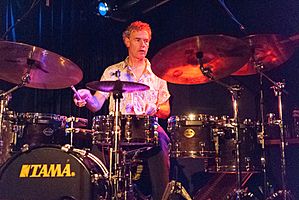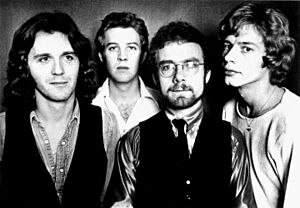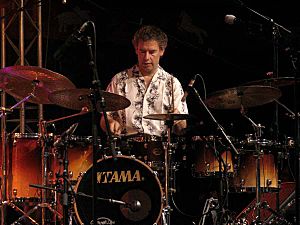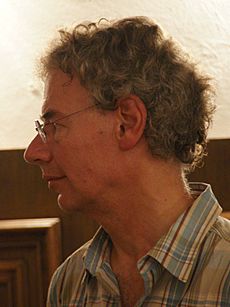Bill Bruford facts for kids
Quick facts for kids
Bill Bruford
|
|
|---|---|

Bruford performing in 2008
|
|
| Background information | |
| Birth name | William Scott Bruford |
| Born | 17 May 1949 Sevenoaks, Kent, England |
| Genres |
|
| Occupations |
|
| Instruments |
|
| Years active |
|
| Labels |
|
William Scott Bruford (born 17 May 1949) is an English drummer and percussionist. He became famous as a founding member of the progressive rock band Yes. After leaving Yes in 1972, Bruford played with other well-known bands. These included King Crimson (1972–1974), Roy Harper (1975), and U.K. (1978). He also toured with Genesis in 1976. In 1978, he started his own band, Bruford.
During the 1980s, Bruford joined King Crimson again for three years (1981–1984). He also worked with several other artists. In 1986, he formed his own electric jazz band called Earthworks. Later, he played with his former Yes bandmates in Anderson Bruford Wakeman Howe. This led to a short return to Yes. Bruford played with King Crimson for a third time from 1994 to 1997. After that, he continued with a new, acoustic version of Earthworks.
In 2009, Bruford announced he was retiring from professional drumming. He then focused on other projects. These included running his two record labels, Summerfold and Winterfold. He also wrote an autobiography and gave talks about music. In 2016, Bruford earned a PhD in Music from the University of Surrey. That same year, Rolling Stone magazine ranked him No. 16 on their list of the "100 Greatest Drummers of All Time". In 2017, Bruford was added to the Rock and Roll Hall of Fame as a member of Yes. After a 13-year break, he returned to playing live in 2022. He is now a member of the Pete Roth Trio.
Contents
Early Life and Musical Start
Bruford was born on 17 May 1949 in Sevenoaks, Kent, England. He was the third child of Betty and John Bruford. His father was a veterinary surgeon. He has an older brother, John, and a sister, Jane. Bruford went to New Beacon School and then Tonbridge School.
He decided to play drums at age thirteen. This happened after he watched American jazz drummers on the TV show Jazz 625. He practiced in his attic. He looked up to drummers like Max Roach and Ginger Baker. His sister gave him drum brushes for his birthday. He practiced with them on album covers. He gradually built his own drum kit. He also took some lessons from Lou Pocock, who was in the Royal Philharmonic Orchestra.
School Bands and Early Gigs
At boarding school, Bruford became friends with other jazz fans. One friend, a drummer, taught him about improvisation. In 1966 and 1967, Bruford played in a band called the Breed. They played R&B and soul music. After school, Bruford took a year off before planning to study economics. In 1968, he tried out for the band Savoy Brown. He didn't get in at first, but he talked his way into it. He only played three gigs with them. He then had a short time with the band Paper Blitz Tissue. Bruford later saw an ad from a band called the Noise. They needed a drummer for a six-week show in Rome, Italy. He found the experience "ghastly" and had to hitchhike back to London.
Music Career
Joining Yes and King Crimson
After returning to London, 19-year-old Bruford put an ad in Melody Maker magazine. Jon Anderson, the singer for Mabel Greer's Toyshop, saw it. The band needed a new drummer. Bruford met Anderson, Chris Squire, and Clive Bayley on 7 June 1968. Anderson was so impressed that he asked Bruford to play with them that night. They only knew one song, "In the Midnight Hour". Bruford was amazed by their singing harmonies. He had other offers, but he chose to stay with Anderson and Squire. They decided to form a new band. Peter Banks joined on guitar, and Tony Kaye on keyboards. The group changed its name to Yes.
Bruford played on Yes's first five studio albums. These were Yes (1969), Time and a Word (1970), The Yes Album (1971), Fragile (1971), and Close to the Edge (1972). He helped write five songs, including "Yours Is No Disgrace" and "Heart of the Sunrise". He wanted his drums to be heard clearly. He developed a unique style with "unusual beat placement" and different time signatures. He learned a lot about music during this time. Bruford remembered that Yes members often argued. He felt that differences in personalities and backgrounds caused constant friction. This was why he eventually left the band.
In July 1972, after Close to the Edge was recorded, Bruford left Yes. He joined King Crimson. He later said King Crimson was one of the few rock bands where he could play complex rhythms. Rehearsals started in September 1972, followed by a UK tour. Bruford was good at remembering difficult drum parts. He learned the long drum and guitar part in "21st Century Schizoid Man" just by listening. He said that jazz percussionist Jamie Muir, who was in the band for six months, greatly influenced his playing. Bruford played on King Crimson albums like Larks' Tongues in Aspic (1973) and Red (1974). Robert Fripp ended King Crimson in September 1974.
New Bands and Collaborations
After King Crimson, Bruford felt unsure about his next steps. In late 1974, he briefly joined the band Gong for a European tour. He then worked as a session musician, playing drums for other artists. In 1975, Bruford played on albums by Chris Squire and Roy Harper. He also played as a guest percussionist for the jazz fusion band Brand X. Later, he joined National Health for some live shows. However, he didn't join them full-time because he felt there were already too many songwriters in the group.
By mid-1976, Bruford had rehearsed with Ray Gomez and Jeff Berlin in the US. But their plans to form a band didn't work out. From March to July 1976, Bruford toured with Genesis. This was for their 1976 tour supporting A Trick of the Tail. It was Genesis's first tour after Peter Gabriel left. Drummer Phil Collins became the lead singer. Bruford knew Collins and offered to play drums until Genesis found a permanent replacement. Bruford is featured in the Genesis: In Concert film and on live albums like Seconds Out (1977). In late 1976, Bruford tried to form a rock trio with Rick Wakeman and John Wetton. But the group quickly broke up.
In 1977, Bruford recorded his first solo album, Feels Good to Me (1978). He worked with Dave Stewart (keyboards), Jeff Berlin (bass), and Allan Holdsworth (guitar). This was Bruford's first big attempt at songwriting. The four musicians stayed together and formed a full-time band called Bruford. Later in 1978, Bruford joined John Wetton to form the progressive rock group U.K.. After their first album, U.K. (1978), Holdsworth and Bruford left. They disagreed on the band's musical direction. Bruford then went back to his own band to release One of a Kind (1979). This album was mostly instrumental. Their last album, Gradually Going Tornado (1980), featured backing vocals from Barbara Gaskin.
King Crimson, Earthworks, and Yes Again
In 1981, Bruford returned to King Crimson. The new band included Fripp, Tony Levin, and Adrian Belew. They recorded Discipline (1981), Beat (1982), and Three of a Perfect Pair (1984). Bruford used both acoustic and Simmons electronic drums. He liked the Simmons drums because they let him play programmed sounds and effects. This expanded his musical options. In 1984, Fripp ended the group again. Bruford said the live album Absent Lovers: Live in Montreal (1998) was one of the best rock albums he played on.
In 1983, Bruford formed a duo with Swiss keyboardist Patrick Moraz. Moraz was also a former Yes member. They called themselves Moraz/Bruford. They released two albums, Music for Piano and Drums (1983) and Flags (1985). These albums were recorded with acoustic instruments. They also played several live shows, including a tour in Japan. In 1985, Jimmy Page asked Bruford to be the drummer for his new band, the Firm. Bruford recalled that they rehearsed briefly but decided they weren't a good fit.
In 1986, Bruford started his jazz group Earthworks. The band included Django Bates, Iain Ballamy, and Mick Hutton. Electronic drum technology had improved, so Bruford used his Simmons kit again. The band toured US clubs in 1987.
Bruford paused Earthworks in late 1988. Jon Anderson invited him to play on a new album with former Yes members Rick Wakeman and Steve Howe. Bruford thought it was for an Anderson solo album. But the four formed a group called Anderson Bruford Wakeman Howe (ABWH). Bruford later said ABWH was mainly a business deal. He joined to help pay for Earthworks. He convinced Anderson to have Tony Levin play bass. Their album Anderson Bruford Wakeman Howe (1989) was followed by a world tour. In 1990, ABWH joined with Yes, forming an eight-member band. The album Union (1991) had songs from both groups. Bruford called it "the worst record I've ever been on." He toured with them in 1991 and 1992. He enjoyed the large crowds but found the experience "pretty horrible." After the tour, Bruford and Howe worked on an orchestral project. It featured Yes songs played with an orchestra, called Symphonic Music of Yes (1993).
Bruford restarted Earthworks in January 1991. They released a studio and a live album. After Bates left, Bruford ended the group in 1993. In the early 1990s, Bruford also became a drum clinician. He taught small groups at several universities.
Later Years and Retirement
King Crimson formed again in 1994 as a six-piece band. It included the 1980s lineup plus Pat Mastelotto (sharing drums with Bruford) and Trey Gunn. This "double trio" released Vrooom (1994) and Thrak (1995). Bruford and Fripp discussed playing improvisational shows together. Fripp then created the ProjeKcts idea. This involved different parts of King Crimson working separately to create new music. Bruford left King Crimson in 1997. He was frustrated with rehearsals that didn't lead to anything. This was also the end of Bruford using electronic drums.
After King Crimson, Bruford focused on acoustic jazz. In 1997, he formed a new version of Earthworks. He used the group to help British musicians gain international experience. This lineup included Steve Hamilton (piano), Patrick Clahar (saxophone), and Geoff Gascoyne (double bass). The band changed members over time but kept a consistent jazz style. They focused on Bruford's songs. In 2005, Earthworks briefly joined with Garland's Underground Orchestra. They formed the Earthworks Underground Orchestra.
During his last years with Earthworks, Bruford worked with other musicians. He collaborated with Eddie Gomez and Ralph Towner in 1997. He also played in the jazz-rock band Bruford Levin Upper Extremities in 1998. From 2002 to 2007, he had a duo with Dutch pianist Michiel Borstlap. In 2003, Bruford started two record labels. Winterfold Records released his rock music. Summerfold Records focused on his jazz music.
Bruford's last public show with Earthworks was on 31 July 2008. It was at Ronnie Scott's Jazz Club in London. In January 2009, at age 59, Bruford announced his retirement from performing and recording. He had been playing for 41 years. He retired due to growing performance anxiety and less stamina for touring. The last studio album he played on was Skin and Wire: Play the Music of Colin Riley (2009). Bruford kept a diary of his shows. He logged 2,885 gigs throughout his career.
Retirement and Return to Music
In early 2009, Bruford published his autobiography. Soon after retiring, he had a short, quiet time playing in Ann Bailey's Soul House. This was a nine-piece band that played Motown and soul cover songs.
In February 2016, Bruford received a PhD degree in Music. He studied for four and a half years at the University of Surrey. He wanted to do something related to music after retiring. He also regretted not going to college in the 1960s. The University of Surrey offered him an honorary doctorate. But he wanted to earn the degree himself. His studies focused on creativity and music performance, especially with a drum kit. Bruford's thesis, "Making it work: Creative music performance and the Western kit drummer", was put online in May 2016. Since then, Bruford has written articles and given lectures at universities.
In April 2017, Bruford was inducted into the Rock and Roll Hall of Fame as a former member of Yes. He attended the ceremony but did not perform or give a speech. In March 2018, Bruford introduced Yes at their London shows for their 50th Anniversary Tour. Later that year, Bruford published his second book, Uncharted: Creativity and the Expert Drummer. This book was based on his PhD research.
In October 2020, Bruford sold much of his personal collection. This included instruments, microphones, and tour cases. In August 2021, his music from Bruford, Moraz/Bruford, and Earthworks became available on streaming platforms. In January 2022, Bruford started his own YouTube channel. He shares videos from his career there. Later in 2022, a 6-CD box set of his music was released. It was called Making a Song and Dance: A Complete-Career Collection.
In 2022, Bruford ended his retirement. He joined the Pete Roth Trio, a jazz group led by guitarist Pete Roth. Roth was Bruford's drum technician over 20 years ago. Bruford said his return to drumming was "explosive, unexpected, and very sudden." He remembered sitting at a drum kit one day and feeling excited to play again. The band plays in small venues, mostly in south-east England.
On 3 August 2023, Bruford made a surprise appearance at the John Wetton tribute concert. He played "Let's Stick Together" with Phil Manzanera, Guy Pratt, and Chris Difford.
Bands Bruford Played With
- Yes (1968–1972, 1991–1992)
- King Crimson (1972–1974, 1981–1984, 1994–1997)
- Gong (Nov–Dec 1974)
- National Health (1975–1977)
- Trigger (Roy Harper Band) (1975)
- Genesis (as concert drummer on A Trick of the Tail Tour, 1976)
- Absolute Elsewhere (1976)
- Bruford (1977–1980)
- U.K. (1978)
- Bill Bruford's Earthworks (Mark I: 1986–1993, Mark II: 1997–2008)
- Anderson Bruford Wakeman Howe (1988–1990)
- ProjeKct One (1997)
- Network of Sparks (1999)
- Bruford Levin Upper Extremities (1998–2000)
- Peter Roth Trio (2022–present)
Timeline of Bands

Personal Life
Bruford married Carolyn in March 1973. They live in Surrey, England. They have three children. One of their children, Alex, was the drummer for the band Infadels.
At Bruford's wedding party, Jon Anderson met Jamie Muir. Muir inspired Anderson to read Autobiography of a Yogi. This book later influenced Yes's double album Tales from Topographic Oceans (1973).
Songwriting Style
In 1982, Bruford talked about writing music for King Crimson. He said it was hard to write for a band where each person was very skilled. He found it difficult to create music that fit everyone's unique sounds.
Influence on Other Drummers
Many drummers have said that Bruford influenced their playing. Some of these include Danny Carey, Mike Portnoy, Matt Cameron, and Brann Dailor. Other artists, like Neil Murray, have also admired his work.
Awards and Recognition
In 1990, readers of Modern Drummer magazine voted Bill Bruford into their Hall of Fame.
Books by Bill Bruford
- Bill Bruford: The Autobiography. Yes, King Crimson, Earthworks and More (2009)
- Uncharted: Creativity and the Expert Drummer (2018)
Discography
Solo Albums (as Bruford)
- Feels Good to Me (1978)
- One of a Kind (1979)
- The Bruford Tapes (1979, live recording)
- Gradually Going Tornado (1980)
- Rock Goes to College (2006, live recording)
Compilations
- Master Strokes: 1978–1985 (1986)
- Making a Song and Dance: A Complete-Career Collection (2022)
- The Best of Bill Bruford – The Winterfold & Summerfold Years (2024)
As a Band Member
- Yes (1969)
- Time and a Word (1970)
- The Yes Album (1971)
- Fragile (1971)
- Close to the Edge (1972)
- Yessongs (1973, live recording)
- Yesterdays (1975; compilation)
- Union (1991)
- Symphonic Music of Yes (1993)
- Union Live (2011, live recording)
King Crimson
- Larks' Tongues in Aspic (1973)
- Starless and Bible Black (1974)
- Red (1974)
- USA (1975, live recording)
- Discipline (1981)
- Beat (1982)
- Three of a Perfect Pair (1984)
- Absent Lovers (1998, live recording)
- VROOOM (1994)
- THRAK (1995)
- B'Boom: Live in Argentina (1995, live recording)
- THRaKaTTaK (1996, live recording)
- Live at the Jazz Café (1999, live recording as part of The ProjeKcts box set)
- VROOOM VROOOM (2001, live recording)
U.K.
- U.K. (1978)
- Concert Classics, Vol. 4 (1999, re-released as Live in America and Live in Boston)
- Ultimate Collector's Edition (2016)
Moraz/Bruford
- Music for Piano and Drums (1983)
- Flags (1985)
- In Tokyo (2009, live recording)
Anderson Bruford Wakeman Howe
- Anderson Bruford Wakeman Howe (1989)
- An Evening of Yes Music Plus (1993)
- Live at the NEC (2012)
Earthworks
- Earthworks (1987)
- Dig? (1989)
- All Heaven Broke Loose (1991)
- Stamping Ground: Bill Bruford's Earthworks Live (1994, live recording)
- Heavenly Bodies (1997)
- A Part, and Yet Apart (1999)
- The Sound of Surprise (2001)
- Footloose and Fancy Free (2002, live recording)
- Random Acts of Happiness (2004, live recording)
- Earthworks Underground Orchestra (2006, live recording)
Bruford with Ralph Towner and Eddie Gomez
- If Summer Had Its Ghosts (1997)
Pete Lockett's Network of Sparks featuring Bill Bruford
- One (1999)
Bruford Levin Upper Extremities
- Bruford Levin Upper Extremities (1998)
- B.L.U.E. Nights (2000, live recording)
Duo with Michiel Borstlap
- In Concert in Holland (2004, live recording)
- Every Step a Dance, Every Word a Song (2004)
- In Two Minds (2007)
Guest Appearances
- Rick Wakeman – The Six Wives of Henry VIII (1973)
- Chris Squire – Fish Out of Water (1975)
- Steve Howe – Beginnings (1975)
- Roy Harper – HQ (1975)
- Various Artists – Peter and the Wolf (1975)
- Pavlov's Dog – At the Sound of the Bell (1976)
- Absolute Elsewhere – In Search of Ancient Gods (1976)
- Genesis – Three Sides Live (1982; live recording)
- Genesis – Genesis Archive 2: 1976-1992 (2000; live recording)
- Genesis – Seconds Out (1977, live recording)
- Annette Peacock – X-Dreams (1978)
- Steve Howe – The Steve Howe Album (1979)
- The Roches – Keep on Doing (1982)
- Al Di Meola – Scenario (1983)
- Annette Peacock – Been in the Streets Too Long (1983)
- Jamaaladeen Tacuma - Renaissance Man (1984)
- Patrick Moraz – Time Code (1984)
- David Torn – Cloud About Mercury (1986)
- Dave Stewart and Barbara Gaskin – Up from the Dark (1986)
- Akira Inoue – Tokyo Installation (1986)
- Anri – Trouble in Paradise (1986)
- The New Percussion Group of Amsterdam, Bill Bruford, and Keiko Abe – Go Between (1987)
- Kazumi Watanabe – The Spice of Life (1987)
- Dave Stewart and Barbara Gaskin – As Far as Dreams Can Go (1988)
- Kazumi Watanabe – The Spice of Life Too (1988)
- Nobuhide Saki - Yume O Yobe (1988)
- David Torn – Door X (1990)
- Steve Howe – Turbulence (1991)
- Joe Hisaishi – Paradise on Earth (1994)
- Tony Levin – World Diary (1995)
- National Health – Missing Pieces (1996)
- Steve Hackett – Genesis Revisited (1996)
- Buddy Rich Big Band – Burning for Buddy: A Tribute to the Music of Buddy Rich, Vol. 2 (1997)
- Gordian Knot – Emergent (2003)
- World Drummers Ensemble – A Coat of Many Colours (2006)
- Piano Circus – Skin and Wire, The Music of Colin Riley (2009)
- Leon Alvarado – Strangers in Strange Places (2010)
See also
 In Spanish: Bill Bruford para niños
In Spanish: Bill Bruford para niños





